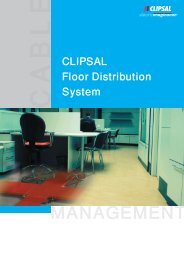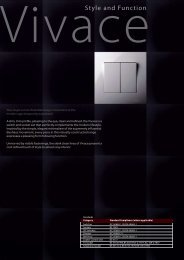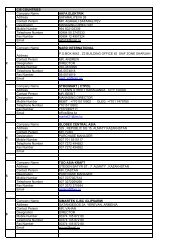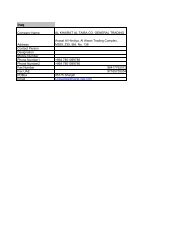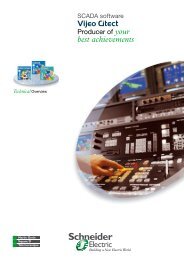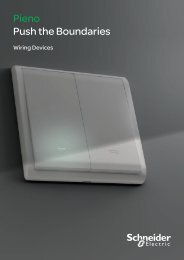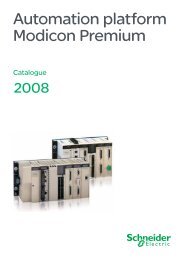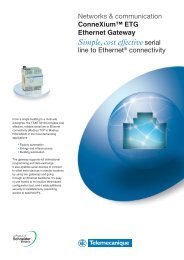Automation platform Modicon Premium - Schneider Electric
Automation platform Modicon Premium - Schneider Electric
Automation platform Modicon Premium - Schneider Electric
You also want an ePaper? Increase the reach of your titles
YUMPU automatically turns print PDFs into web optimized ePapers that Google loves.
1<br />
2<br />
3<br />
4<br />
5<br />
6<br />
7<br />
8<br />
9<br />
10<br />
Functions,<br />
references<br />
Processor without PCMCIA card<br />
1/30<br />
Internal RAM<br />
Presentation:<br />
page 1/26<br />
32 to 96 Kwords<br />
Data<br />
Program<br />
Constants<br />
1 Application data (30.5 Kwords max.)<br />
2 Task descriptor and executable code<br />
3 Constant words, initial values and configuration<br />
Processor with PCMCIA card<br />
Internal RAM<br />
PCMCIA card<br />
(slot no. 0)<br />
32 to 176 Kwords<br />
64 to 512 Kwords<br />
30.5 Kwords<br />
32 Kwords<br />
128/640<br />
Kwords<br />
128/256<br />
Kwords<br />
Data<br />
Program<br />
Constants<br />
Additional<br />
data<br />
storage<br />
Symbols storage<br />
1 Application data (30.5 Kwords max.)<br />
2 Task descriptor and executable code<br />
3 Constant words, initial values and configuration<br />
4 Depending on the model of PCMCIA card<br />
Description:<br />
page 1/27<br />
1<br />
2<br />
3<br />
1<br />
2<br />
3<br />
4<br />
4<br />
<strong>Modicon</strong> <strong>Premium</strong><br />
automation <strong>platform</strong><br />
PL7 processors<br />
Memory structure<br />
The application memory is divided into memory areas, which are physically<br />
distributed across the internal RAM memory and the PCMCIA memory extension<br />
card(s):<br />
b<br />
b<br />
b<br />
The application data area is always in the internal RAM.<br />
The application program area is in the internal RAM or the PCMCIA memory card.<br />
The constants area is in the internal RAM or the PCMCIA memory card.<br />
There are two ways of organizing the application memory for<br />
TSX P57 1p3/2p3/2p23M and TSX P57 3p3/3623/453/4823AM processors with or<br />
without a memory extension installed in the form of a PCMCIA format card:<br />
Application in internal RAM<br />
The application is completely loaded into the processor's battery-backed internal RAM (1),<br />
the capacity of which depends on the processor model (32 to 96 Kwords).<br />
For example, the TSX P57 1p3M processor has 7.5 Kwords of application data and<br />
24.5 Kwords of program, constants and system data (2).<br />
The memory space (32 Kwords) is shared between the application data, the<br />
program, the constants and the system data (2).<br />
Application in the PCMCIA card (slot no . 0)<br />
The internal RAM is reserved for the application data.<br />
The PCMCIA card contains the program and constants (64 to 512 Kwords).<br />
The file storage area of 128 K or 640 Kwords (depending on the model of PCMCIA<br />
card) can be used in remote applications, for storing production data information,<br />
recipes, etc.<br />
The symbols storage area of 128 K or 256 Kwords (depending on the model of<br />
PCMCIA card) enables the application symbols database to be stored on the PLC.<br />
Extension of the additional data storage area (slot no . 1)<br />
This area, containing 128 or 640 Kwords, can be extended up to 2688 Kwords by using<br />
an SRAM TSX MRP DS 2048P/MFP 004MPCMCIA memory card. This card is inserted<br />
into the lower slot on TSX P57 2p3/2p23M, TSX P57 3p3/3623/453/4823AM<br />
processors and can be used in conjunction with memory extension cards (type 1 in the<br />
upper slot).<br />
Data in internal RAM<br />
The data area can be extended to up to 30.5 Kwords. It is only supported by the<br />
PLC's internal RAM.<br />
PL7 Junior/Pro software helps the application designer to manage the structure and<br />
organize how the memory space on the <strong>Premium</strong> PLC is occupied.<br />
Protecting the application<br />
Regardless of the PLC memory structure (whether the application is located in the<br />
internal RAM or on the PCMCIA card), it is possible to protect the application so that<br />
it cannot be accessed (for the purpose of reading or modifying the program) in online<br />
mode under PL7 Junior/Pro.<br />
A memory protection bit, set in configuration mode, is also available to prevent any<br />
program modification (via the programming terminal or downloading).<br />
<strong>Premium</strong> processor references<br />
TSX 57 10/20/30/40 processors are equipped with:<br />
b A PCMCIA slot (no. 0) that can accommodate a memory extension or SRAM<br />
memory card for the purpose of storing additional data<br />
b A PCMCIA slot (no. 1) that can accommodate a communication card or memory<br />
card for the purpose of storing additional data<br />
b Two terminal ports (8-way female mini-DIN type), Uni-Telway or character mode.<br />
TSX 57 processors are double-format modules (except TSX P57 1p3M and<br />
TSX P57 353LAM processors, which are single-format).<br />
TSX 57 30/40 processors support the loading of programs, via the terminal port, at a<br />
maximum speed of 115 Kbit/s (limited to 19.2 Kbit/s for TSX 57 10/20 processors).<br />
The integrated Fipio link (bus manager) on TSX 57 20/30/40 processors supports a<br />
maximum of 127 connection points. The link on the TSX P57 153M processor is<br />
limited to 63 connection points.<br />
___________________________________________________________________________<br />
(1) The internal RAM is protected by an optional battery with a life of 3 years, which is located in<br />
the power supply module .<br />
(2) The system has a minimum reserve RAM memory area in the order of 5 Kwords. Please refer<br />
to the PL7 Micro/Junior/Pro reference manual.<br />
Functions:<br />
page 1/30<br />
References:<br />
pages 1/30 ...


